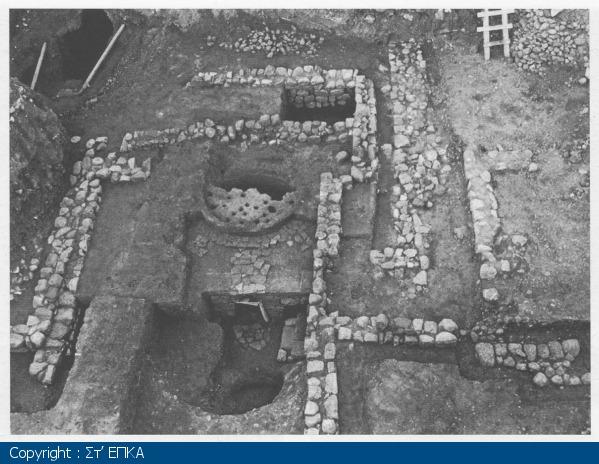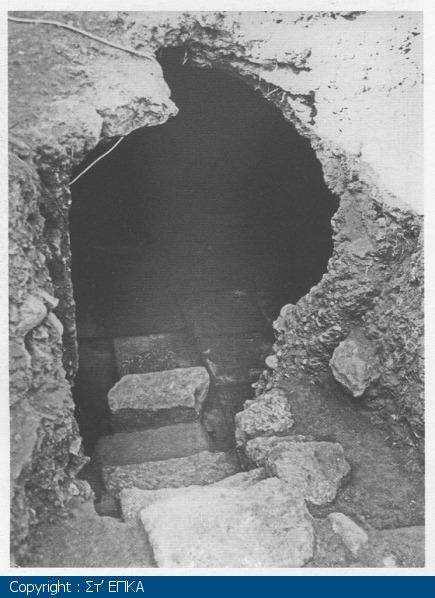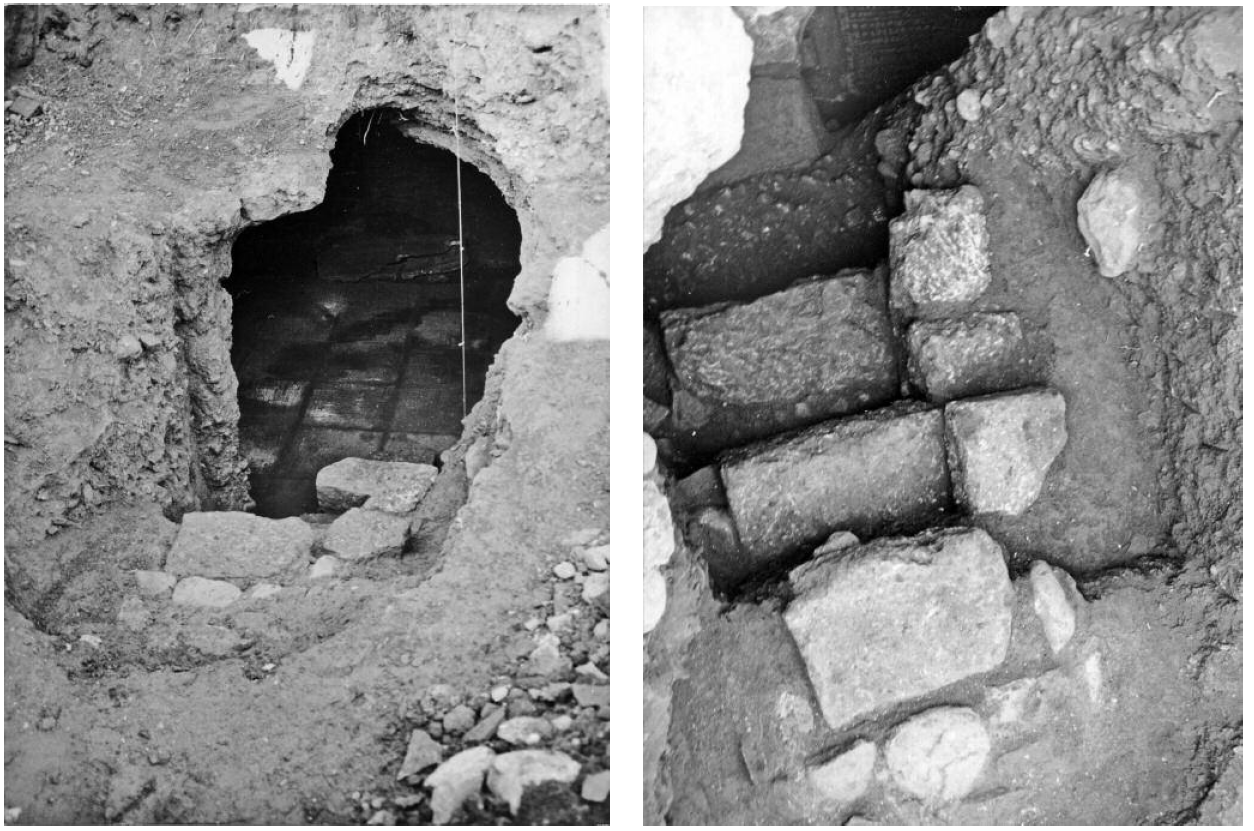
CIMRM Supplement - Mithraeum. Aigio/Aigion/Aegio, Greece.





In 2001 an underground chamber was found at the Greek town of Aigio, and identified as a Mithraeum. The identification was made by the excavator, E. Kolia, based on the arrangements of the room. Dr Kolia also discusses the tauroctony found at nearby Patras a century ago (CIMRM 2351), which may be connected.
From the abstract of the academia article:
The rescue excavation in the plot at 19 Sotiriou Lontou in modern Aigio has revealed a shrine to Mithras, a god of Persian origin whose cult was widely expanded in the roman empire. The underground cave was cut into the conglomerate rock of the area, and a flight of eight steps of stone slabs led to it. Its dimensions are 4.5 x 4 m, and its floor was paved with large square clay slabs. At the western side of the cave, opposite the entrance, an apse was carved in the rock, where the cult relief or the statue of the god once stood. The shrine dates to the second half of the 2nd century-first half of the 3rd century AD, the main period of the expansion of the cult of Mithras in the roman empire.
The god’s shrine in Aigion is not the unique evidence of the existence of Mithraic communities in Achaea. In 1912 a votive relief that shows Mithras slaying a bull was found in Patras, a Roman colony and the most important harbour in western Greece. It is probable that Roman veterans and italian merchants (negotiatores) who had settled in Achaea were responsible for the expansion of the god’s cult in the area. future research is expected to provide us with a bulk of information on several issues concerning Mithras and his cult in western Greece.
The website of the French school at Athens has this description:
Aigion, 19 Sotiriou Lontou Street (Maleviti property). E.-I. Kolia (Στ’ ΕΠΚΑ) reports the discovery of a Hellenistic potter’s workshop with at least two phases of use. A well-preserved kiln was found in the centre of the plot with workshop structures around it. The kiln was 4m long with a round chamber 2.22m in diameter, built of brick which had vitrified on the interior face. The eastern part of the eschara was preserved although the superstructure was not. The clay floor preserved the central support for the eschara. The stoking tunnel, at the east, was built of tile and terracotta briquettes, with a vaulted entrance. East of the entrance, a pit contained much burnt material (ash and carbon) and a few sherds.
In the southwest corner of the plot was a subterranean rock-cut chamber (the basement of a building above), considered to be a Mithraeum. The upper part of the chamber entrance lay ca 1.15m below present street level, with eight steps down into it. The rectangular structure, with interior dimensions of 4.5x4m (and a height of 2.6-2.68m) had a terracotta tiled floor: the walls and floor were covered with lime plaster. Along the north wall were the foundations of a large built bench. In the northwest corner a long opening dug through the floor led down to a tunnel cut into the rock. A shallow niche was cut into the middle of the west wall, reaching down to floor level, with a rectangular base placed on the floor. In the southeast corner was a niche which had its lower edge defined with decorative brickwork, and there was a further niche by the entrance. The chamber fill contained much evidence of burning, especially in the northeast part, as well as Roman pottery, animal bones and a few glass vessels. Immediately to the south of the chamber, a Late Roman wall lay almost at the surface.
Notes from my translation of Dr Kolia's article, via Google Translate:
In the northwest corner, at the level of the floor, a tunnel was carved into the natural rock that advances to the northwest. (Fig. 4) Its height reaches approximately 1.70 m, its length is 4.5 m, while it goes below the adjacent plots, where it branches to north and south. The length of its branches is unknown, since it was impossible for us to investigate for safety reasons.
In the middle of the west side of the chamber opposite the entrance there is a shallow concave area, carved into the conglomerate rock, that reaches the floor and has a pendulous end at its top (fig. 4). Its shape is irregular, which may be due to the erosion of the rock. At the bottom there is a rectangular structure, probably a base, which was broken and dropped to the floor from its original position, which was slightly higher (Fig. 4). Finally, at the southeast corner of the chamber, there is a smaller niche in the middle of the wall, also carved in the rock.
The chamber contained a large amount of Roman ceramics and many animal bones. Most of the ceramics can be dated to the late 2nd century. A.D., or the first half of the 3rd century. AD, which is considered as the main period of use of the underground room. This dating is reinforced by Corinthian type 27 (XXVII) lamps with the characteristic embossed rosette on the disk or embossed rays in the disk and shoulder rim and other ceramic classes (Fig. 5), such as the large panel belonging to the so-called African pottery red and dated just before the middle of the 3rd century AD.
The underground chamber in Aigio must have been a cult area, as evidenced by its elaborate construction and its morphology, the excavations, and some indicative finds. These data lead us to identify it with Mithras.
...
The Mithraea, then, were underground "caves", natural or artificial. This usually involved a small scale. These two basic elements are found in the underground sanctuary of Aigio. Another fundamental feature that exists in the cave of Aigio is the niche in the middle of the opposite side of the entrance. Also, there was a built-in bench along the north side, while the absence of the second bench on the south side should be attributed to the tightness of the space. The devotional relief was probably destroyed or removed when the place ceased to have a cult character in late antiquity. Enigmatic is the tunnel in the northwest corner, between the niche and the the bench footing. Perhaps it lead to an auxiliary room with a spring, or possibly a reservoir, as water played an important role in the rituals of Mithras.
Inside the cave, but also externally, in front of the entrance and on the archway covering the steps, there were strong traces of combustion. The soil contained numerous animal bones, derived from cattle, goats, and perhaps wild boar. Inside the chamber several horned horns (Fig. 6), oysters and olives were found. These remains are signs of sacrifice and sacred dinners in this area. It is known that the basic element of the Mithraic worship was the common ceremonial dinners after the sacrifice of the bull or other animals. Indeed, the morphology of the Mithras temples with the two bearings resembles a symposium room rather than a temple. It is characteristic that, in the excavations of Mithraea almost throughout the Roman Empire, there has been found large quantities of bones of animals from cattle, pigs, sheep and goats, birds, but also fish.
An important indication, for the identification of the underground cavernous chamber in Aegio as a sanctuary of Mithras, is the fragmentary red-coloured small plate or bottle with the embossed interior decoration (Figure 1). Around the base, there is a bull running to the right, and legs of human form in stride also to the right.
In Mithraea, several samples of red-and-white pottery have been found that have a relief decoration of bull hunting and its killing by the god, or other motifs and animals related to Mithras, and generally scenes found on devotional reliefs. It seems that these vessels were votive offerings of the faithful and were specially made for the Mithraic rituals. Almost all of the above vases belong to the North African red ceramics, such as the Aegean flask. The vase probably depicts a scene from the bull hunt as the animal appears to be running.
Characteristic is the ceramic from the underground chamber, which consists of a large number of shell cookware with their traces of use (fig. 7), tableware, amphorae, basins and bowls (fig. 8). These vases are common findings in most Mithraea, since they are vessels that are directly related to the ceremonies, and especially with their common dinners and their preparation.
Bibliography
- E. Kolia, "The Cult of Mithras in Aigion", in: L'Acaia e l'Italia Meridionale. Contatti, scambi e relazioni dall'Antichità ai nostri Giorni, Atti del Convegno, Eghio, 6-9 Luglio 2006, 208-221. Online at Academia.edu here (in Greek).
| Tweet |





